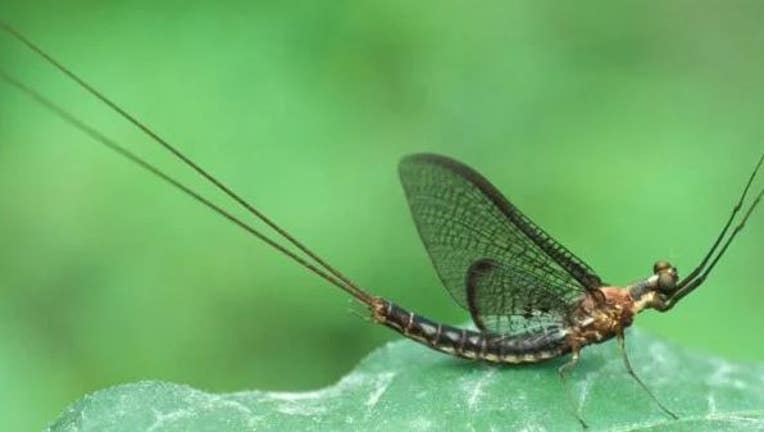Mayfly swarms emerging from the Great Lakes for summer mating season

Mayflies spend most of their life as nymphs underwater - except for a short period in the summer when they breach the surface and take to the skies.
(FOX 2) - Mayflies have one mission when they sprout their adult wings and take to the skies: find a mate and then make it back to a watery habitat to lay eggs.
Or, as Dr. Christine Mayer puts it, "they hook up and die."
"The flying stage that we see only lasts a couple days. They don't have a mouth, so they're done growing," said the ecology professor, who teaches at the University of Toledo. "All they do is mate."
The time period that Southeast Michigan sees mayflies is jarring since it comes with swarms of the insects flocking to spotlights and lamp posts, later littering the ground after they've found a mate. But this stage is only a sliver of their life cycle, which mostly happens underwater.
After two years of growing in the beds of lakes and rivers, mayflies typically emerge in June. But predicting where they show up is a trickier
The mayflies Southeast Michigan is familiar with spawn out of Lake Erie and Lake St. Clair. As of mid-June, they still haven't made an appearance in Michigan. They have made landfall in Ohio where Mayer works, however.
RELATED: Swarm of bugs picked up on Detroit, Cleveland weather radars
Her place of employment was "covered in them" after they emerged last week, she said, which means it may not be too long before Metro Detroit sees them as well.
"When they come out, there will be bursts of them," Mayer said. "However, they're not strong fliers, and they get moved around by the wind. If a swarm emerges, it could get pushed onto land in Ohio or Michigan."
Mayflies spend the majority of their lives as nymphs, where they burrow themselves beneath the bed of water environments to avoid predators. While underground, they feed on detritus and algae.
Bottom feeding may seem like an unglamorous place to be in the food web, but it's an important role for the entire ecosystem since mayflies serve as a foundational layer of food for fish and other organisms that live in lakes and rivers.
MORE: Red pines in northern Michigan trimmed to promote seed growth
Without them, the transfer of energy from leftover organisms to upper levels of the food chain couldn't happen.
Their life cycle's second stage resembles an adult but lacks the organs necessary to breed. Finally, when they're ready to find a mate, they take flight. If they survive the journey to the surface, avoiding hungry fish and water fowl along the way, they'll sprout wings and go in search of a mate.
It happens in pulses big enough to register on the weather radar as clouds.
These swarms gravitate toward light, but usually it's the wind that pushes them around. If pushed far enough, they'll arrive along the coasts, and eventually in the cities where light pollution is more abundant and attracts them.
They may bring the "ick" factor with them, but Mayer emphasizes they are no threat to people.
"They are not harmful," she said. "They can't bite, they can't hurt you in anyway unless one flew into your eye - they ones out of Lake Erie are honkers."
If you'd like to avoid them entirely, the best someone can do is turn off their lights at night.

